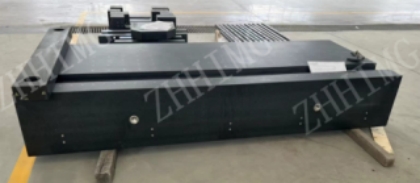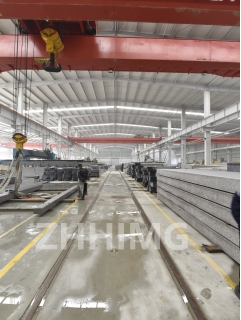The granite platform, as a reference tool for precise measurement and processing, its accuracy maintenance directly affects the production quality. The following provides a systematic maintenance plan covering environmental control, daily maintenance and professional calibration to ensure that the platform maintains nanometer-level accuracy for a long time.
1. Environmental Control: Build a precision protection barrier
Temperature and humidity management
The working environment temperature needs to be stabilized at 20±1℃. Every 1℃ fluctuation will cause thermal deformation of the granite platform at 0.5-1μm/m. A constant temperature system can be installed in the workshop to prevent the air conditioning outlets from blowing directly onto the platform.
The humidity should be controlled between 40% and 60%. Excessive humidity can easily cause rust on metal parts, while too low humidity may lead to static electricity interference in measurement.
Vibration isolation
The platform should be kept away from vibration sources such as stamping machines and milling machines. It is recommended to maintain a distance of more than 3 meters from vibration equipment.
If vibration cannot be avoided, air spring shock absorbers can be installed at the bottom of the platform to reduce the impact of environmental vibration on the flatness of the platform (which can reduce external vibration by more than 80%).
2. Daily Maintenance: Meticulous control from cleaning to protection
Surface cleaning specification
Dust removal: Wipe the surface with deerskin or a lint-free cloth in the same direction every day to prevent dust particles (≥5μm) from scratching the platform. Stubborn stains can be gently wiped with anhydrous ethanol (purity ≥99.7%). Strong solvents such as acetone must not be used.
Degreasing: If it comes into contact with oil stains, wipe it with a diluted neutral cleaner, then rinse with deionized water and air dry to prevent mineral oil from penetrating the tiny pores of the platform.
Load and collision protection
The load-bearing capacity of the platform should be controlled within 70% of the rated load (for example, for a 1000kg platform, it is recommended that the load be ≤700kg) to avoid permanent deformation caused by local overload.
It is strictly prohibited to strike workpieces on the platform. When handling tools, wear soft gloves to prevent sharp objects from scratching the surface (scratches with a depth greater than 20μm will affect the measurement of the reflected light path).
3. Professional Calibration: The Core of scientifically maintaining accuracy
Calibration cycle setting
Conventional usage scenarios: Calibrate once every quarter and use a laser interferometer to detect flatness (with an accuracy of ±0.5μm/m).
High-frequency use or harsh environments: Monthly calibration, with a focus on monitoring temperature-sensitive areas (such as the edge of the platform near heat sources).

Post-calibration processing
If the flatness deviation is found (such as > ±1μm/m), it must be ground and repaired by a professional technician using W1.5 micro-powder. Self-grinding with sandpaper is strictly prohibited.
After calibration, data should be recorded and archived, and a platform accuracy attenuation curve should be established to predict maintenance requirements in advance.
4. Storage and Transportation: Avoid hidden precision loss
Key points for long-term storage
When storing, it should be covered with a moisture-proof and dust-proof cover. The bottom should be supported by three points (the support point is located at 2/9 of the platform's length) to prevent bending deformation caused by gravity (a 1-meter platform may sag by 0.3μm due to long-term single-point support).
Move the position of the platform support points regularly (monthly) to avoid long-term local pressure.
Transportation protection plan
Short-distance transportation: Wrap with shock-absorbing foam, fix within a rigid frame, and keep the acceleration within 2g.
Long-distance transportation: It needs to be vacuum-packed and filled with dry nitrogen. After arrival, it should be left to stand for 24 hours until the temperature reaches equilibrium before unpacking to prevent condensation water from affecting the accuracy.
5. Fault Prediction: Techniques for Identifying Early Problems
Visual inspection: Regularly observe the surface with a 40x magnifying glass. If continuous scratches or a significant decrease in gloss are found, it may indicate a decline in accuracy.
Sound detection: Tap the platform gently. If the sound becomes hoarse (normally it should be a clear sound), there may be micro-cracks inside. Stop using it immediately for detection.
Through this maintenance system, the ZHHIMG® granite platform can maintain a flatness of ±1μm/m for 10 years, which is more than three times longer than the precision life of platforms that are not properly maintained. Practice has proved that after a certain semiconductor factory adopted this solution, the frequency of platform calibration was reduced by 50%, and the annual maintenance cost was saved by more than 150,000 yuan.
Post time: Jun-18-2025

